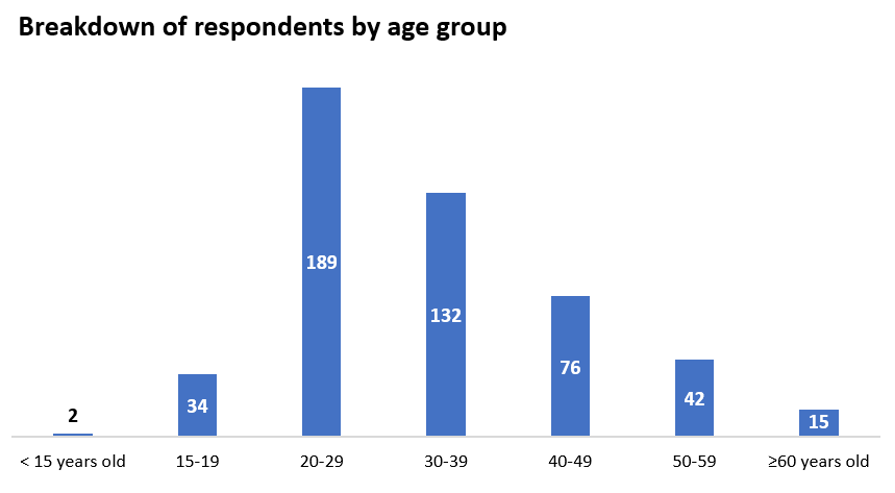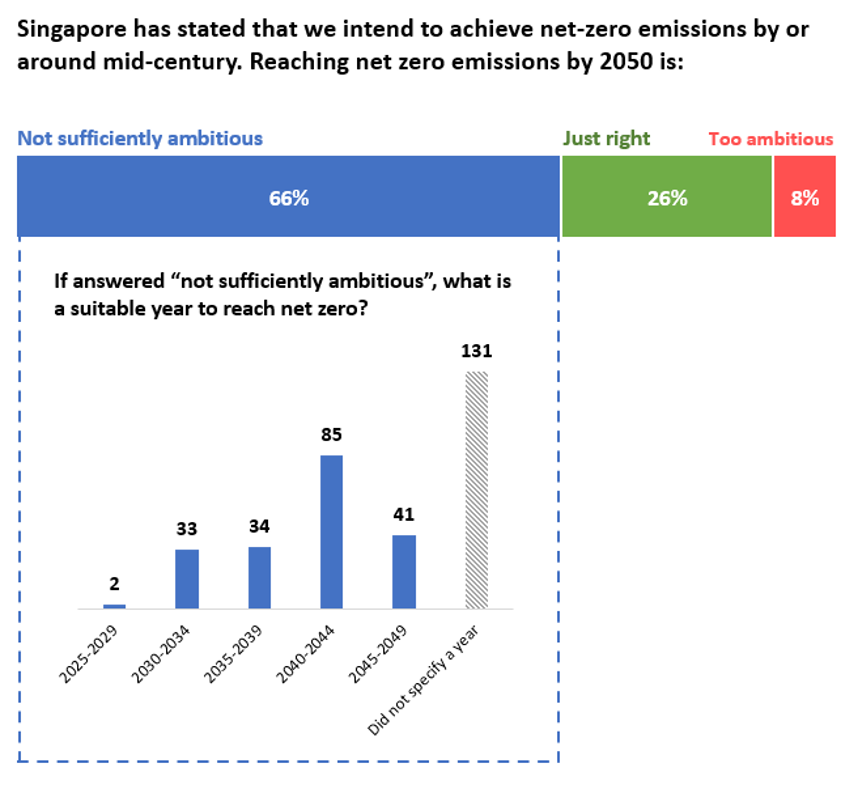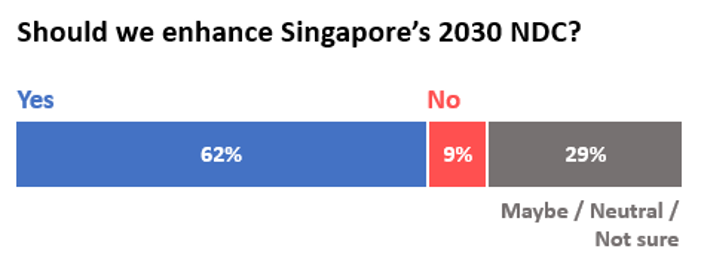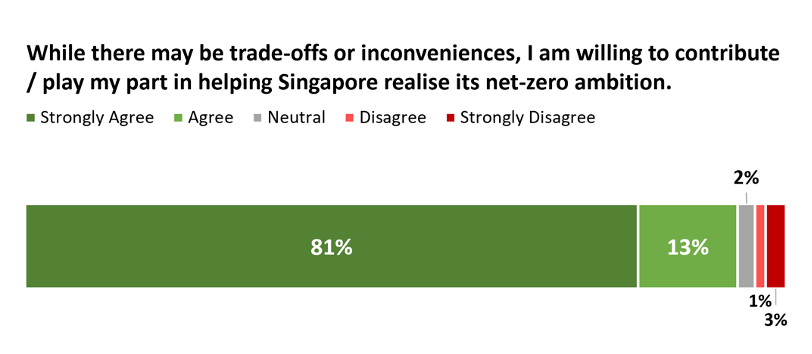(25 Oct 2022) Feedback Received from REACH PC on Singapore's Raised Climate Ambition
The National Climate Change Secretariat (NCCS) conducted an online public consultation through REACH on Singapore’s climate ambition from 5 to 26 September 2022. We received 490 responses from members of the public and representatives of businesses and NGOs. The breakdown by age group is shown in Figure 1. Prior to this public consultation exercise, the Government had engaged more than 1,200 stakeholders from various segments of society, including youths and representatives from businesses, green groups, academia and NGOs, under the Singapore Green Plan 2030.
 Figure 1: 73% of respondents were aged 39 or below.
Figure 1: 73% of respondents were aged 39 or below.
2. A summary of the feedback from the public consultation can be found below. The Government will take the suggestions received into account as Singapore implements its revised Long-Term Low Emissions Development Strategy (LEDS) and 2030 Nationally Determined Contribution (NDC).
Climate Ambition
3. 66% of all respondents felt that the proposed enhancement to Singapore’s climate ambition to achieve net-zero by 2050 was “not sufficiently ambitious”, while 26% agreed that it was “just right” (Figure 2). Those who indicated that Singapore was “not sufficiently ambitious” were asked to propose a suitable net-zero year. 126 respondents specified a year between 2040 and 2049. In response to the question on whether Singapore should enhance its NDC, 62% of the 304 [1] respondents that responded to the question agreed that there was scope to enhance Singapore’s 2030 NDC (Figure 3).
 Figure 2: 66% of respondents said that Singapore’s ambition to achieve net zero by 2050 was not sufficiently ambitious. 195 respondents further suggested an alternative year, of which 126 respondents specified a year between 2040 and 2049.
Figure 2: 66% of respondents said that Singapore’s ambition to achieve net zero by 2050 was not sufficiently ambitious. 195 respondents further suggested an alternative year, of which 126 respondents specified a year between 2040 and 2049.
 Figure 3: 62% of 304 responses agreed that Singapore should enhance its 2030 NDC.
Figure 3: 62% of 304 responses agreed that Singapore should enhance its 2030 NDC.
4. 94% of all respondents agreed that while there may be trade-offs or inconveniences, they were willing to make a contribution and play their part to help Singapore realise its net-zero ambitions (Figure 4).
 Figure 4: 94% of all respondents agreed that they were willing to play their part in helping Singapore achieve its net-zero ambition.
Figure 4: 94% of all respondents agreed that they were willing to play their part in helping Singapore achieve its net-zero ambition.
Summary of Suggestions Raised in Qualitative Feedback
Respondents provided the following feedback:
(I) Catalyse Business Transformation
5. Pivot away from emissions-intensive industries. Singapore can diversify its economy and pivot away from emissions-intensive industries such as the Energy and Chemicals sector. The Government can set concrete targets for reducing sectoral emissions, or to increase the output of sustainable products from Jurong Island.
6. Businesses to implement decarbonisation plans. Businesses can put in place decarbonisation plans, commit to net zero targets such as the Science Based Targets initiative, and factor Environmental, Social and Governance (ESG) considerations into their business models, for instance, by incorporating a carbon cost in their financial analyses, or tying ESG outcomes to executive pay. Businesses can encourage employees to adopt environmentally friendly behaviours. They can also pivot to offer more sustainable goods and services, such as reducing packaging, which would make it easier for individuals to live a lower-carbon lifestyle. The Government can put in place both incentives — such as grants and subsidies — and disincentives to nudge companies in the right direction. Small and Medium Enterprises (SMEs) might particularly require assistance with the green transition.
7. Encourage emissions reporting. Businesses can steer clear of greenwashing practices by strengthening their carbon monitoring and reporting practices for greater accountability. Companies can also look into measuring and disclosing their Scope 3 emissions. The Government can consider making the reporting requirements for businesses mandatory through legislation.
8. Provide support for workers in a green transition. The Government can reskill and provide support to affected workers, as part of broader efforts to build a workforce ready for the green economy.
9. Make available green financing. The Government and financial institutions can cease funding local and overseas fossil fuel projects, divest from fossil fuels, and provide financing for businesses looking to transition away from fossil fuels.
(II) Invest in Low-Carbon Technologies
10. Invest in clean energy. Singapore can ramp up investment in and deployment of alternative energy technologies, for instance, solar, by incentivising private home and building owners to install them. Singapore can reconsider nuclear power as a strategy for both sustainability and supply resilience, given recent advances in technology.
11. Encourage green R&D. The Government can partner businesses to accelerate Singapore’s decarbonisation by investing in R&D of novel green technologies.
(III) Pursue Effective International Collaboration
12. Import electricity. Recent developments to import clean energy from Malaysia and Laos are a step in the right direction, and the Government can accelerate its efforts to develop the ASEAN power grid to reduce Singapore’s dependence on natural gas. Electricity imports can be held to Singapore’s standards and regulations, so that green projects carried out overseas do not adversely affect the local community and environment. Singapore can implement an impact assessment framework for such projects.
13. Purchase carbon credits as last resort. Singapore’s plans to develop capabilities as a carbon services hub are a move in the right direction. Singapore can prioritise achieving actual reduction in absolute emissions first, and purchase carbon credits as a last resort.
(IV) Adopt Low-Carbon Practices
14. Embrace nature. Singapore can look into more nature-based solutions, and prioritise preserving the country’s forests, mangroves and other natural habitats, which can contribute to carbon storage.
15. Promote green commutes. Singapore can continue to improve and electrify the public transport system and commit to phasing out internal combustion engine (ICE) vehicles. Singapore can ramp up electric vehicle (EV) charging infrastructure and the energy grid to support the growth of EVs.
16. Encourage green infrastructure. Singapore can enhance its regulations to reduce building energy consumption, such as by raising energy-efficiency requirements for buildings and setting a minimum temperature for air-conditioning. Singapore can also consider the preservation and retrofit of older buildings where possible, in lieu of new construction projects, given substantial amounts of embodied carbon in building materials like cement and steel.
17. Individuals to embrace green lifestyles. Individuals can adopt a lower-carbon lifestyle by cutting down on meat consumption, taking more public transport, reducing consumption, and supporting green businesses. Even though individual carbon footprints are dwarfed by industry emissions, shifts in consumer behaviour can help send a positive signal to the Government and private sector. Individuals can also participate more actively in conversations on climate change, and initiate discussions and ground-up approaches to support Singapore’s journey to a low-carbon future.
18. Government to catalyse green lifestyles. The Government can facilitate and catalyse green lifestyles. For instance, it can strengthen the local agri-food scene to reduce emissions from food imports while increasing Singapore’s supply chain resilience. The Government can also consider a ban on single-use plastics, and provide more subsidies for the installation of smart devices to improve household energy efficiency. To accelerate societal change, Singapore can increase publicity and education on climate change by including sustainability in the school curriculum and encouraging climate-friendly behaviours.
19. The Government can take the lead and continue public consultation. The Government’s efforts under GreenGov.SG are a step in the right direction. It can continue to lead by example, and consult the public on its climate change policies and plans. There can be greater transparency on data, analyses and trade-offs considered.
(V) Right-Pricing Carbon to Shape Business Decisions and Consumer Behaviour
20. Calibrate the carbon tax. The Government’s decision to raise the carbon tax progressively to S$50–$80/tCO2e by 2030 is in the right direction. It can consider further increasing the carbon price, and lowering the emissions threshold of 25ktCO2e for industrial facilities to include smaller emitters. It can also consider a progressive system of taxation in which larger emitters, and those with greater means, should bear higher costs. For transparency, the Government can disclose carbon tax allowances given to companies, particularly those that contribute significantly to the nation’s carbon emissions. It can also consult the public and disclose its criteria for determining eligible carbon credits to offset carbon tax.
21. Support for transition. The Government can provide more support to households, especially vulnerable and low-income segments of society, to ensure they are not adversely affected by the carbon tax and other climate change policies.
Conclusion
22. NCCS wishes to thank all individuals, businesses and organisations for their feedback.
[1] 186 survey respondents did not answer this optional question.

